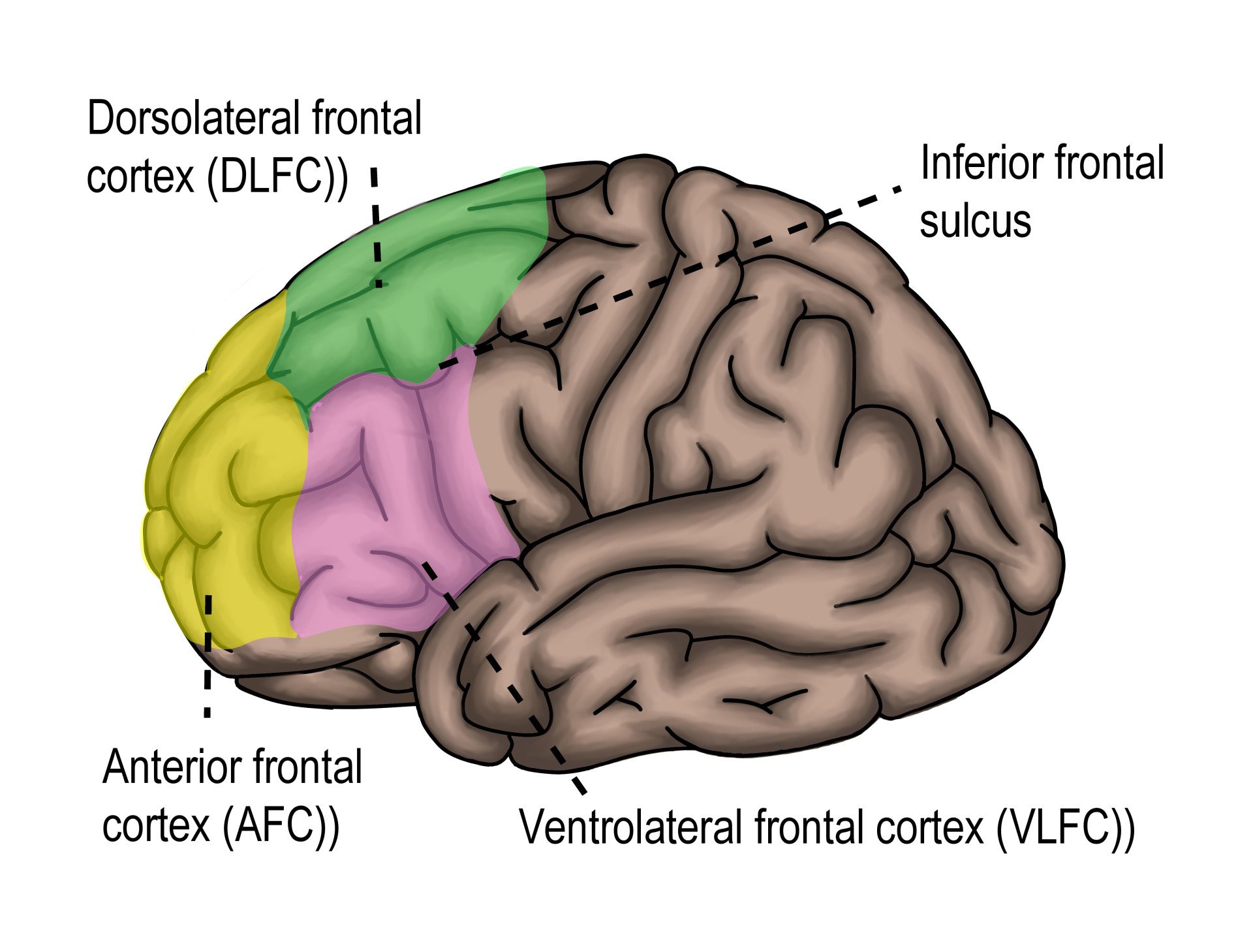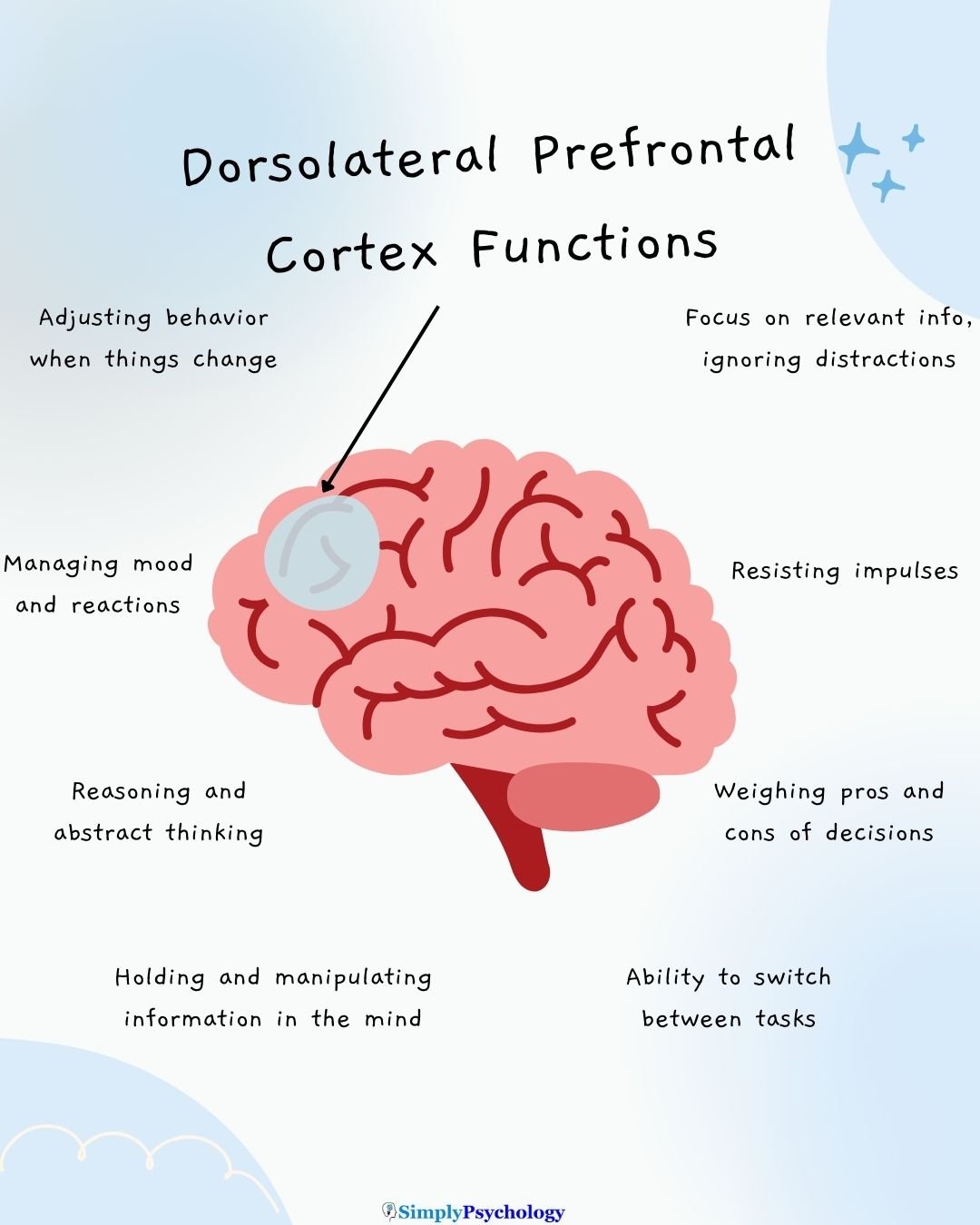As a psychology student, understanding the dorsolateral prefrontal cortex (DLPFC) is important because it’s central to many of the core topics you’ll study: attention, memory, decision-making, self-control, and mental health.
When you learn about executive functions, you’re really studying the capacities that the DLPFC helps support.
In experiments using tasks like the Stroop test, the Wisconsin Card Sorting Test, or working memory tasks (e.g. n-back), the DLPFC is active and often a focus of measurement, because changes in its functioning tell us how people think, adapt, and learn.
It also comes up in clinical psychology: many disorders (e.g. depression, ADHD, schizophrenia) involve differences in DLPFC function.
Knowing how the DLPFC is studied, what goes wrong, and how it can be strengthened or compensated for gives you a bridge between theory and application.

Location and Structure
The dorsolateral prefrontal cortex (DLPFC) is a part of the frontal lobe of the brain. It sits toward the top and side (dorsolateral = dorsal + lateral) of the prefrontal cortex.
You can find it on the middle frontal gyrus, which is one of the ridges on the brain’s surface in the frontal lobe. Wikipedia+2ScienceDirect+2
In terms of Brodmann areas (a system dividing the cortex into numbered regions based on how the cells are organized), the DLPFC mainly covers Brodmann Area 9 and Area 46.
Area 9 is more toward the top (dorsal) side of the frontal lobe, and Area 46 is slightly more toward the middle (lateral) side, but both are very close and often work together.
The DLPFC is connected to many other brain regions: sensory areas (for input), memory-related areas like the hippocampus, and subcortical structures like parts of the thalamus and basal ganglia.
This network of connections lets the DLPFC integrate incoming information, keep things in mind, plan actions, and control behaviour.
Laterality matters: for example, verbal tasks (language work) tend to activate more of the left DLPFC, while spatial and visual tasks often use more of the right DLPFC.
Functions of the DLPFC
The dorsolateral prefrontal cortex (DLPFC) is one of the brain’s key regions for executive functions and higher-order cognition. That means it helps with thinking tasks where you have to plan, hold information in mind, make decisions, and control your behaviour.

Working Memory and Attention
Working memory is like a mental scratchpad: the ability to hold and work with information in your mind for short periods.
The DLPFC is especially important for manipulating information—not just remembering it, but rearranging it, comparing items, or updating what’s relevant.
For example, if you remember numbers and then have to sort them in your head, the DLPFC helps with that.
Attention is also guided by the DLPFC. It helps you focus on what’s important and ignore irrelevant distractions.
It also helps you shift your focus when needed — perhaps from listening in class to taking notes, then back again. This ability to flexibly shift and maintain attention is essential to learning and problem-solving.
Decision-making and Problem-solving
The DLPFC contributes to decision-making by helping you evaluate different options and think about consequences.
When you weigh pros and cons, predict what might happen, or choose between short-term reward vs long-term benefit, the DLPFC is active.
Problem-solving often involves planning steps, dealing with unexpected obstacles, and adjusting strategies.
The DLPFC supports flexible thinking — meaning if your first idea doesn’t work, you can switch to a new approach. It also helps when you have to stay goal-oriented, keeping in mind what you want to achieve and resisting distractions.
Emotional Regulation and Self-Control
Emotional regulation means being able to manage your feelings so that they’re appropriate for the situation.
The DLPFC plays a big part here by helping suppress or adjust emotional reactions when necessary (for example, cooling down anger, or resisting impulses). It helps you think before acting, rather than acting purely out of emotion.
Self-control is closely related: it’s the ability to resist temptations, delay gratification (choosing a bigger reward later rather than a smaller one now), or ignore impulses.
Studies show that greater activity in the DLPFC is associated with better self-control in tasks (e.g., resisting unhealthy food choices) and that disrupting DLPFC activity makes self-control harder.
Development and Plasticity of the DLPFC
The DLPFC isn’t fully mature at birth – in fact, it keeps developing through adolescence and into early adulthood.
During the teen years, the structure of the DLPFC changes: the thickness of its cortex tends to thin over time, which is thought to be a sign of pruning away unused neural connections and making the remaining ones more efficient.
Also, white matter (nerve fibres that help different brain areas communicate) increases in the prefrontal cortex during this period, helping signals travel faster.
These physical changes coincide with improvements in executive functions: adolescents become better at planning, focusing attention, resisting impulsive responses, and switching tasks.
As the DLPFC matures, these high-level thinking skills become more reliable and flexible.
Neuroplasticity means the brain can change with experience, and the DLPFC is plastic. Learning new high-demand cognitive tasks (like working memory training) can increase activity in the DLPFC, recruit more neurons, or alter how neurons fire in response to a task.
Also, therapies, education, or structured training can strengthen connections or improve control over behaviour and emotion via the DLPFC.
Clinical Relevance of the DLPFC
When it is impaired or underactive, many psychological disorders show deficits in these areas. Problems can include difficulty keeping thoughts in mind, poor planning, trouble shifting attention, and weak self-control.
These impairments can seriously affect a person’s daily functioning — school, work, social life.
Below are some specific disorders where DLPFC dysfunction plays a role.
Depression and Mood Disorders
In major depressive disorder (MDD), studies often find that the left DLPFC is underactive. This underactivity is linked with symptoms like negative thinking, low motivation, and difficulty initiating behaviour.
When treatments like transcranial magnetic stimulation (TMS) successfully increase DLPFC activity, people’s depression symptoms often reduce.
This suggests that part of depression’s cognitive symptoms may come from a failure in the DLPFC’s ability to regulate mood and control negative thought patterns.
ADHD and Executive Dysfunction
Attention-Deficit Hyperactivity Disorder (ADHD) is another disorder where the DLPFC often shows reduced function.
People with ADHD may struggle with working memory deficits, which means they find it harder to hold information in mind and use it.
They may also have difficulty with impulse control and resisting distractions. Brain imaging studies show that networks involving the DLPFC are less active or less well-connected in ADHD compared to neurotypical individuals.
These impairments help explain symptoms like forgetfulness, interrupting others, and trouble finishing tasks, which are common in ADHD.
Schizophrenia and Other Conditions
In schizophrenia, DLPFC dysfunction is associated with more severe cognitive deficits, such as problems with memory, planning, and organizing thoughts.
The DLPFC tends to show reduced activity or abnormal connectivity with other brain regions like the cerebellum.
These changes are linked with disorganized thinking, difficulties in following conversations or tasks, and sometimes psychosis (hallucinations or delusions).
References
Asgharian Asl, F., Abbaszade, S., Derakhshani, H., Vaghef, L., & Asgharian Asl, A. (2024). Unilateral vs. Bilateral DLPFC rTMS: Comparative effects on depression, visual-spatial memory, inhibitory control and cognitive flexibility in major depressive disorder. Frontiers in Psychiatry, 15, 1400414. https://doi.org/10.3389/fpsyt.2024.1400414
Benschop, L., Vanhollebeke, G., Li, J., Leahy, R. M., Vanderhasselt, M., & Baeken, C. (2022). Reduced subgenual cingulate–dorsolateral prefrontal connectivity as an electrophysiological marker for depression. Scientific Reports, 12(1), 1-11. https://doi.org/10.1038/s41598-022-20274-9
Kumari, V., Peters, E. R., Fannon, D., Antonova, E., Premkumar, P., Anilkumar, A. P., Williams, S. C., & Kuipers, E. (2009). Dorsolateral Prefrontal Cortex Activity Predicts Responsiveness to Cognitive–Behavioral Therapy in Schizophrenia. Biological Psychiatry, 66(6), 594. https://doi.org/10.1016/j.biopsych.2009.04.036
Smucny, J., Dienel, S. J., Lewis, D. A., & Carter, C. S. (2021). Mechanisms underlying dorsolateral prefrontal cortex contributions to cognitive dysfunction in schizophrenia. Neuropsychopharmacology, 47(1), 292. https://doi.org/10.1038/s41386-021-01089-0

